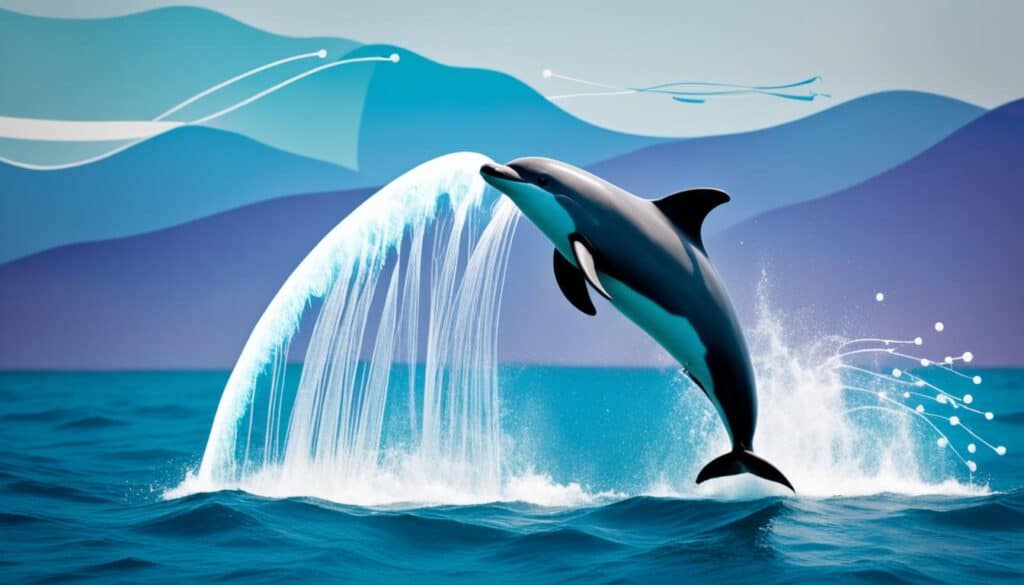Porpoises live in groups and use sound to talk to each other underwater. You might ask, how do they do it? Unlike many sea creatures, porpoises don’t use sight or smell to communicate. They use sound, which is key for their social life. This article will explore how porpoises talk to each other, including their sounds, echolocation, and how they interact with others. It’s important for those who study marine mammals or want to protect the ocean.
Understanding Porpoise Communication
Porpoises use sound to talk to each other and find their way in the water. This special way of communicating is key to their social and survival skills in the sea.
Definition of Porpoise Communication
Porpoises use sounds like clicks and whistles to talk to each other. These sounds help them in complex social activities. They are important for finding a mate, hunting, and staying together as a group.
The Importance of Sound in Marine Environments
Since it’s hard to see underwater, sound is crucial for porpoises to communicate. Sound travels well in water, letting them talk over long distances. This helps them find friends, avoid dangers, and stick together as a group.
How do porpoises communicate?
Porpoises have amazing ways to talk to each other using sounds. They make different porpoise vocalizations to send messages and connect with others. These sounds include clicks, whistles, and special pulses. Each sound has its own meaning in their social and environmental world.
Vocalizations and Clicks
High-frequency clicks are the main way porpoises talk to each other. These clicks are key for social chats, finding food, and moving through the water. Each click can show different feelings or plans, showing how complex porpoise communication is.
Echolocation—Seeing with Sound
Porpoise echolocation lets them see by using sound waves. They send out clicks and listen for the echoes to know what’s around them. This skill is crucial for underwater communication, helping them judge distances and spot objects in dark waters. Echolocation is essential for survival, giving them vital info about their surroundings and where to find food.
Porpoise Vocalizations: High-Frequency Clicks
Porpoises make unique sounds, especially high-frequency clicks. These clicks are key to their communication and finding their way around. Let’s dive into how these sounds are different from those of other sea creatures.
Narrow-Band High-Frequency (NBHF) Clicks Explained
Narrow-band high-frequency clicks are a special part of porpoise talk. They can hit up to 150 kHz, helping porpoises learn about their world without being seen by predators. Making these clicks involves special air sacs and phonic lips. This skill is vital for talking and finding things by sound.
Comparison with Dolphin Communication
Porpoises and dolphins both make sounds, but they sound different. Dolphins make a variety of sounds, like whistles and wide clicks. Porpoises stick to high-frequency clicks. This shows how they’ve adapted to their own homes and social lives.
Patterns of Vocalization during Social Interactions
When porpoises hang out together, they chat with clicks and sounds. You might hear more clicks and sounds together. These chats help them stay friends, move together, and more. It shows how important these sounds are to their social life.

Social Signals in Porpoises
Learning about porpoise social signals is key to understanding their complex ways of communicating. These signals are very important, especially for mothers and their babies. They help porpoises talk to each other and even other animals. This shows how smart and connected they are.
Mother-Calf Communication
The way mothers and calves talk to each other is a big part of porpoise social signals. They use sounds to share important messages. This helps the young ones learn how to survive and grow up.
Porpoises use sound a lot to teach their babies. This creates a strong learning space for the calf.
Interactions with Other Species
Porpoises also talk to other animals in the sea. This shows how flexible their way of communicating is. They can even talk to animals that are not porpoises. This is really interesting and helps us learn more about their lives in the ocean.
The Role of Echolocation in Communication
Echolocation is key to porpoise language, serving as a way to navigate and communicate underwater. They send out clicks that hit objects and come back, helping them figure out where things are. This method is used in social settings or when hunting, letting porpoises share info about their surroundings and what’s nearby.
Studies show that porpoises use echolocation for more than just finding their way around. It’s a big part of how they talk to each other. Each click can tell others how close something is and what’s happening around them. In groups, their echolocation sounds change, showing a complex way of communicating.
This shows how porpoises are able to adapt in their underwater world. They use echolocation to improve their social interactions, making it easier to work together in groups. Seeing how they use both sounds and echolocation to communicate shows how deep their social lives are.
FAQ
How do porpoises communicate?
Porpoises mainly use sound to talk to each other. They make clicks, whistles, and pulses. These sounds are key for social life and finding their way underwater.
What types of vocalizations do porpoises use?
Porpoises make different sounds, like high-frequency clicks for finding things and talking. These sounds share important info and help them stick together.
How does porpoise echolocation function?
Porpoises send out sound waves that hit objects and then come back. This lets them “see” their world underwater. It’s key for finding food and getting around.
What is the significance of sound in marine environments for porpoises?
Sound is super important underwater because it’s hard to see. Porpoises use sound to talk over long distances. It helps them stay connected and find their way.
How do mother-calf porpoise communication dynamics work?
Moms and calves talk a lot using sounds. The calf learns how to survive and follows its mom’s advice. This helps them bond.
Do porpoises interact with other species?
Yes, porpoises talk to other sea creatures like dolphins. They show how complex their communication can be. It’s interesting to see how they adapt to talk to others.
How do porpoise vocalizations compare to those of dolphins?
Porpoises and dolphins both make sounds, but they’re different. Porpoises mainly use high-frequency clicks. Dolphins make a wider range of sounds, like whistles. This shows they communicate in their own ways.
What are the roles of social signals in porpoise interactions?
Social signals are key for porpoises. They tell others about their relationships, how close they are, and their place in the group. These signals help keep their social groups strong.







